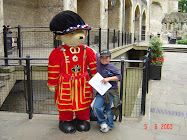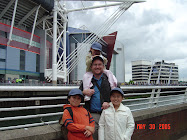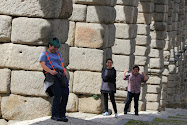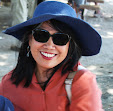Medellin at night. (Photo by Matt Actis)
A week ago, we came back from our trip to Colombia. My experience defied my pre-conceived idea about the country and its people. Our purpose in going there were was two-fold: to make ourselves available to help the Christian workers in that area (mission trip), and to see and enjoy Colombia and what it has to offer (fun trip). It was a great trip. And I will try to preserve details of our experiences by writing them down.
The City
We spent ten days in Medellin as our central station. From there we travelled to different towns around. Medellin is like a huge
bowl - a city that is on the mountains and surrounded by even higher mountains. I believe that it is a
caldera - created a long time ago through the collapse of the ground due to a major tectonic activity. In the valley there are hills which probably were formed through later volcanic eruptions. There is a limited flat area in the city. The houses and buildings are built on the slopes. Moving around the city means either climbing up or going down stairs.
Poorer communities are situated on the higher part of the mountains.
The pictures don't show but Medellin looks like a Lego-land that is made of bricks. Bricks are the most noticeable building material throughout the city. The mountains are predominantly clay - thus brick is the most practical material for building walls. At night when the city is lit, it looks like a huge bowl that is over-flowing with twinkling gems. In short, it is beautiful. I imagine that in every building, you get a view of the city.
At an elevation of 4905 ft (1495 m), Medellin has a very pleasant temperature - and because it is located on the equator, the temperature remains relatively constant throughout the year. During our time in Medellin, it rained every night and was sunny with some clouds during the day. The funny thing was that the people, complained,
"Hace calor", meaning "It's very hot", whenever they are exposed to the sun. Then when they are in the shade, they'd be saying
"Muy frio." (It's v ery cold.) I guess people's reaction to climate is all relative. For me, Medellin was very pleasant through and through.
People and their Food
Medellin is a city in the state of Antioquia. The people born in this state call themselves "Paisa" and they are proud to be so. There is a food combination which they call as "
Bandeja Paisa". This is composed of eleven different ingredients: ground meat, blood sausage, beans, rice, fried plantain, arepa, chorizo, egg, avocado, chicharones, and something else. Every Paisa is proud to serve this to their most honored guests. If you happen to be one of their guests, you can be gracious by sampling all of the components of the huge platter of food. The individual components of the bandeja are applied in different dishes. For example - arepa was served every day during the ten days that we spent in the area.
One of the best ways to learn about a culture is to visit a local market or at least a grocery store. In Medellin, we got to wander in a huge open market called Minorista; it is full of different fruits and vegetables - most of them are only found in Colombia. I was surprised to see that there is a big section dedicated to meats as opposed to a tiny fish section. Corn and potatoes are the other single commodities that took up a huge area in the market place.
I enjoyed eating fresh fruits everyday and drinking freshly squeezed juice. Sometimes the juices are mixed with milk to tame the acidity that comes from the fruits. On the other hand, some fruits are served with a drizzle of lime juice and a sprinkling of salt to achieve the same effect on fruits.
Arroz con Coco, Patacon and Fried fish
Avocados, mangoes, pineapple,
maracuja (a species of passion fruit), blackberries,
lulo (Spanish common name -
naranjilla) and
guanabana (soursop) are all very common. Except for avocado, they can all be made into delicious drinks either
"con leche" or
"con agua". There are a lot more fruits that I could not identify found in the market place.
Potato, along with yucca (cassava) and corn, is a huge part of their diet. Every Colombian I talked to seem to pay homage to the potato. I was surprised to hear Maria (who cooked for us during our stay in Medellin) talk about the differences between three types of potatoes in Colombia. I've learned from my research that the three most popular potatoes in Colombia are Papas Criollas (
Solanum phureja 'Criollas'), Sabanera (
Solanum tuberosum 'Sabanera') and Pastusa (
Solanum tuberosum 'Pastusa') The
Criollas are small yellow potatoes which are very creamy; they are used in a lot of their dishes but I like eating them roasted or boiled with a little bit of butter.
People and their Customs
Colombians are very friendly and hospitable people. They serve
aguapanela (a drink made with dissolved blocks of molasses with a lime juice)
, tea, and
tinto (black coffee) to show their hospitality and affection. They are also fun to be with. For example, Magdalena and Oscar came to dance for us. Then they encouraged us to dance with them as well. We tried... Everything would have been perfect for establishing good relationships with the Colombian people. However, they speak only one language - Spanish. This is a problem because I do not speak Spanish. I realize that friendship requires a common or shared language. It's difficult to be friendly when we cannot express our thoughts nor understand the thoughts of the other person. Thanks to people we met like Miriam and Jim Marquardt and Manuel Ramos who interpreted for us when my daughter Shannon was not around. When I listened carefully, I could get a general idea of what they were saying. The Filipino language and dialects contain many Spanish words and I recognize them. However, I know nothing about Spanish grammar. I cannot conjugate verbs, thus speaking it was not an option.
I tried hand motions and exaggerated facial expressions - surprisingly enough, sometimes they worked.
It was a Thursday night when we arrived in Medellin. The following Sunday was a big night because Medellin's "Nacional" played against Bogota's "La Equidad" soccer team. These two cities have an on-going competition; each citizen claim that their city is the better one. The Nacional won and you can guess what happened that night. The whole city was in a mode of jubilation. Screaming, honking, shooting of guns into the air, waving of flags and banners at every passing vehicle, fireworks, and drinking were everywhere. It was a very happy night for the whole of Medellin but it kept me awake until I decided to use ear plugs. Later that week we went shopping in Hunin. I was bargaining on the price of a Colombian flag when the vendor decided to give it to me at a very low price because his team Nacional won the previous game.
Colombians do not go out in flip-flops. They are always in shoes or at least sandals. I am glad that we were pre-warned about this custom. When it comes to bathroom- manners, Colombia and Belize share something in common. Toilet paper does not go into the toilet; it goes into the trash can. I know it is hard to imagine but it is true. Along the streets or near parks you'd see vendors selling sliced fresh fruits arranged in plastic cups and you can eat them with
palitos (toothpicks).
The Seminary
In Medellin, we stayed at the apartments which are owned by the Biblico Seminario, the only bible seminary in the city. Our friends Matt and Shelley Actis and their family live there while they prepare themselves for their ministry in Armenia, Colombia.
The seminary campus is located on a hill, of course, on one side of the street. This is the side where we met with our hosts on a daily basis and ate our meals. On the other side of the street are the apartments where we stayed. We did not have to climb hills but we had to climb up to the third floor many times a day. Having lived and walked in El Dorado Hills for eleven years, I would have been prepared for this terrain. However, the altitude provided an unexpected challenge for my lungs.
Both sides of the campus are gated. So every time we entered or went out, someone would open the door for us - manually on one side and mechanically on the apartment-side. That means that during the course of the day the gates were opened for us
at least eight times. The good thing is that we felt protected.









